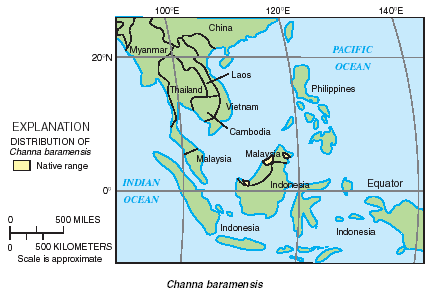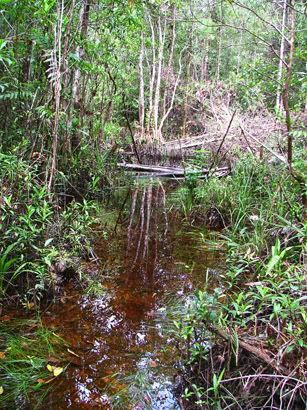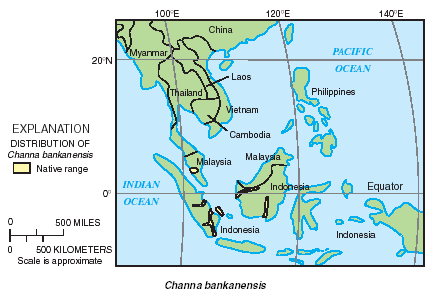updated to add info and keep upto date 7th nov 2008
Species name: Channa punctata
Common name: green snakehead, dolla or daula snakehead ,spotted snakehead
Maximum size: approx 30 cm / 12 inches, varients may differ in size slightly but some are still new to the trade so final size is still unknown
Origin: Afghanistan, Pakistan, India, Sri Lanka, southern Nepal , Bangladesh, Myanmar(suspected mis-identifacations of channa panaw), southwestern China
Introduced range: southern Mosambique, (poss - only one specamin found and could of been an ilegal release ,no other specamins have been found in southern africa since, so no evidance to prove it is established.
Temperament: can be aggresive to its own kind as well as other fish , but one of the less aggresive channa
Company: Channa punctata is as with all members of the group channide best housed as a bonded pair or single fish, take extreame caution if mixing with other fish , again this fish is prone to choke on fish it cannot swallow and is equally prone to bullying from more aggresive fish.
Water parameters: Temperature ,temperate to tropical upper lethal limit is 40 c lower lethal limit is 9 c
again try and find out where your fish comes from to be able to provide the best possable care pH know to be able to stand a very wide ph range from ph 4.3 - 9 somewhere in the middle of this would be a good place to aim for
Feeding: young feed primarily on zooplankton, with rotifers, insect, and crustacean larvae constituting most of the diet , Adults consume fishes, insects , stomach contents reviel aquatic vegitation is also consumed but this is most likely a bycatch of there normal prey. i have whitness the same in my aurantimaculata ,they are often seen with some leaves hanging out there mouths after wolfing down there food that has fell and rested on a plant, this is another important reason why aquatic vegitaion is so important in a channa set-up
tank set-up: since this species is found in a very wide range ,some detective work is needed from the keeper to provide the best conditions for your variant of this fish , however when this information is not available it is useally safe to set-up the tank on middle ground, head for neutral water and low tropical temps around 24deg , structure the tank well with plants and wood , floating cover via surface plants , as allways the more secure the fish feels the more you will see it
other information: standard varients of this species are useally fairly easy to locate ,and often appear on import lists and is one of the species you may find in some of the better local stores. specalist store should have little problem finding this fish for you. however the newer varients of this fish are still extreamly rare and do not appear often in the trade ,some of the specalist shops get them in from time to time , standard varients and useally fairly cheep in the uk , infact probably the cheepest snakehead in the trade , the latest found varients such as sp. greenfins still comand high amounts of money , a good size sp. greenfins will set you back around £100-£150 yet the same fish in standard form can be bought for as lillte as £9.99 i have seen juvinile fish for sale locally for £3.50


























